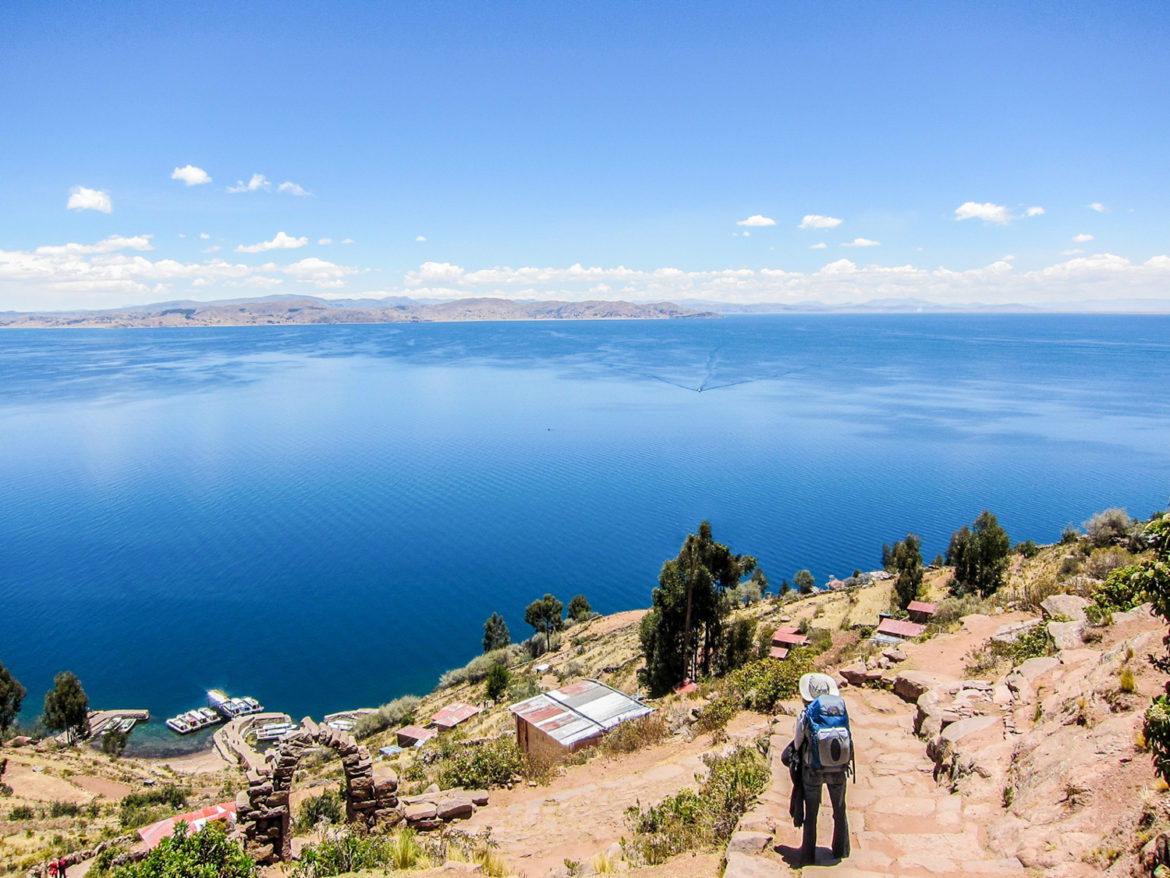Taquile is one of 40 inhabited islands in Lake Titicaca, situated on the border of Peru and Bolivia.
Taquile is best known for its beautiful textile art and community of knitting men. The island and its traditions have been recognized by UNESCO as “Masterpieces of the Oral and Intangible Heritage of Humanity.” For centuries, men have knitted intricate textiles and clothing considered to be among the highest quality handicrafts in Peru. They start learning how to knit around eight years old. Meanwhile, young girls are taught the craft of weaving, specifically chumpis, wide belts worn by both men and women. Amazing on a small island of just 2000 people, these iconic textiles are created and sold all over Peru.
We arrived in Taquile by community boat from Amantani, just several miles away. It was our second overnight homestay with an island host family (as well as our second day without a shower.)
Upon docking, several locals greeted us, then led us up 512 steps to the official entrance to the island.
Seeing us struggle with the steep ascent, two teenage Taquileño girls offered to carry our backpacks. Mortified, we assured her we were fine. We continued up, trying to muffle our breathlessness which took even more effort. It wasn’t just the steepness that made the climb challenging. Taquile is 13,000 feet above sea level so like in Cusco, we were feeling the effects of soroche (altitude sickness).
The views from the top were absolutely gorgeous. Against the backdrop of the massive, deep blue lake, tidy red-roofed homes dotted the terraced hillside. Essentially, each house acts like a mini-farm with an individual plot of land. This land has been passed down from centuries of terrace farming. From growing crops to raising animals (cows, sheep, chickens), every family works hard to remain self-sustainable.
We enjoyed lunch with a few other tourists also staying overnight on the island. A local man talked to us about the culture of knitting and other traditions like eating coco leaves to relieve headaches from the altitude. Afterwards, we all went our separate ways to meet our individual host families.
We had been assigned as guests to Thomas, his wife Ines and their three adorable children.
As we approached the home, Thomas greeted us, dressed in the traditional Taquile men’s outfit. He wore a peasant-style blouse, black vest and pants, a wide cummerbund and a knit hat with a big pom pom on the end. This is the signature knit hat that all Taquile men wear. The color and design of the hat varies according to the wearer’s age and social status. A solid red hat signifies being married while one with a white stripe means the man is single.
Like Amantani, the family spoke no English or Spanish – only Quechua – an indigenous language of Peru. The young children huddled closely to their parents and studied us with timid curiosity. We learned they had surprisingly western names: Jessica, Lizbeth and (ironically) Brian. Thomas showed us to our room and once again, we found ourselves in a humble abode with no electricity or power. Yet the room was clean, comfortable and most importantly, complete with an outhouse.
Exploring the island, we visited the main square (Plaza de Armas) where a dozen or so men were knitting away. At first, it seemed like a staged scene. As if a local on the lookout saw gringos coming and cued knitting men into the square. But no, this was just a typical day in Taquile.
Such a strange sight to see adult men catching up on the latest island gossip over knit and purl stitches.
Brian approached one elderly man and decided to try and communicate in basic Spanish. To our surprise, the man replied back. Brian asked how long he had been knitting. He responded, “Cincuenta años” (50 years). Wow!
Off the main square, we followed a cobblestone path through the island “neighborhoods” on the 3.5 mile-long land mass. Married couples were working hard, tending the land together before the sun set. We passed some kids who, given their large backpacks, were making their way home from school. They squealed with excitement as they pushed rubber hoops with plastic water bottles cut in half. At just five or six years old, they were all unsupervised – not a care in the world and obviously no concern for danger. We couldn’t help but think how that sort of freedom just doesn’t seem to exist for kids in the states anymore.
Continuing our trek, we made our way past ancient ruins, prayer rocks and sacred grounds to reach the highest point in Taquile.
At the only restaurant around (thankfully that was open), we rewarded ourselves with a sunset happy hour. Sitting in blissful silence, we took in the panoramic views. For a while, it felt as if no one else existed. Just then, the lone silhouette of a girl, wearing a traditional black chuko (headdress), appeared on the rocks below us. Like us, she simply sat taking in the wonder of the sunset in quiet solitude.
As we sipped on our Cusqueña beers, we reflected on the fact that Taquile is likely all this girl knows of the world. To some, this island life might seem like a stifling existence. But with a tight-knit community, a beautiful culture and an incredibly idyllic setting, it was hard to convince ourselves that she was missing out on anything from our modern world.
If anything, it made us long for a simpler, kinder, more communal way of life back home.

